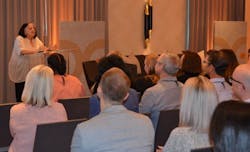Joyce Bromberg Talks Disruption in the A&D Industry for Design Connections 2.0 Keynote
The workplace design pioneer, who spent part of her career at Steelcase, revealed the impact of technology has had on spatial design.
Rather than basing design decisions on numbers—how many people can fit into this conference room or workplace, for example—Bromberg noted that during the evolution of workplace design, people began asking the question, “What if we designed spaces not on numbers, but on what people were actually doing in them?”
Referring to activity-based planning, the office became more responsive to users’ needs and moved away from the cubicle farms of the past.
The Great Recession introduced another major disruptor to the workplace: uncertainty.
No longer able to predict the size of their organizations, Bromberg says this change led to the desire by companies for flexibility—shorter leases and the ability to expand and contract as needed, which led to the co-working trend that we see today.
Of course, change is constant, and Bromberg predicts that another major disruptive force is on the way.
“There will be another big inflection point when singularity happens. When [artificial intelligence] overtakes human intelligence, it will change everything,” she said.
Designing for the Future
With that in mind, the question Bromberg posed to designers is, “How can we utilize foresight and think about what might be?”
She said we need to look at the leading edge of what’s happening in the world to see where it’s going, but also look to people right next to them to see how what other people do can affect the work that interior designers do.
In practical terms, Bromberg offered the following strategies:
- Use big data to inform design decisions
- Look at what people actually do, not what you think they do—and invite end users to design with you
- Take the unpredictability out of construction
- Integrate space and technology, and create smart rooms that help people solve problems
- Provide the ability for people to customize and personalize
Quoting from computer scientist Alan Kay, Bromberg suggested that “the best way to predict the future is to invent it.”
Focus on Users
It was Bromberg’s first time attending the Design Connections 2.0 event, put on by interiors+sources. Ahead of her keynote, she spoke with associate editor Adrian Thompson.
“Meeting needs isn’t just about efficiencies and economies of scale,” she explained. “It’s also about meeting the needs and desires of your user.”
If you missed the presentation or want to know more, you can read our profile interview with Bromberg, coming soon.
This article was first posted Oct. 4, 2019 and updated Oct. 8, 2019. Adrian Thompson also contributed to this article.
Read next: Technology Reshapes the Future, But Human Element Remains Front and Center
About the Author
Robert Nieminen
Market Content Director
Market Content Director, Architectural Products, BUILDINGS, and interiors+sources
Robert Nieminen is the Market Content Director of three leading B2B publications serving the commercial architecture and design industries: Architectural Products, BUILDINGS, and interiors+sources. With a career rooted in editorial excellence and a passion for storytelling, Robert oversees a diverse content portfolio that spans award-winning feature articles, strategic podcast programming, and digital media initiatives aimed at empowering design professionals, facility managers, and commercial building stakeholders.
He is the host of the I Hear Design podcast and curates the Smart Buildings Technology Report, bringing thought leadership to the forefront of innovation in built environments. Robert leads editorial and creative direction for multiple industry award programs—including the Elev8 Design Awards and Product Innovation Awards—and is a recognized voice in sustainability, smart technology integration, and forward-thinking design.
Known for his sharp editorial vision and data-informed strategies, Robert focuses on audience growth, engagement, and content monetization, leveraging AI tools and SEO-driven insights to future-proof B2B publishing.

